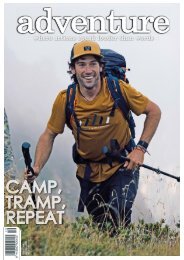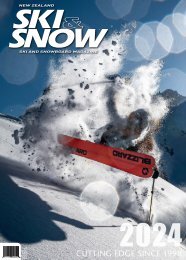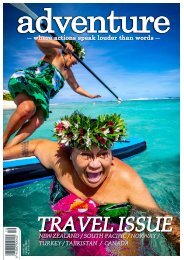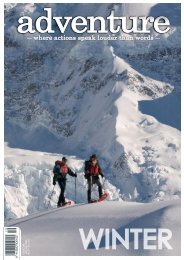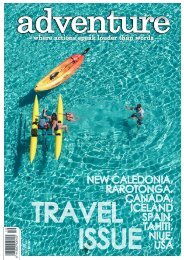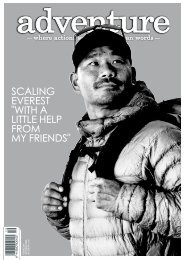Adventure Magazine
Issue 230, February/March 2022
Issue 230, February/March 2022
Create successful ePaper yourself
Turn your PDF publications into a flip-book with our unique Google optimized e-Paper software.
Left to right: Historic sink plundered from the wreck of the Waikare, recovered by our team in Luncheon Cove.<br />
Rob Edward - James Croker and Eddie Howard descend to the black coral.<br />
Some of the 40 batteries recovered<br />
Opposite page: Stuart Day and Rob Wilson clear their safety stop and prepare to ascend after the tyres they have sent to the surface.<br />
Now fast forward to 2021 now our third<br />
visit to Dusky, the dive team suit up into<br />
their drysuits and Halcyon kit, ready<br />
to dive in this incredibly exclusive and<br />
isolated location. In all honesty I was not<br />
expecting what we usually encounter<br />
with our typical Ghost Diving dives or<br />
when we dive for Project Baseline Clyde<br />
Quay. Surprisingly enough, the sight I<br />
saw was not so dissimilar!<br />
Bubbles roared from the exhaust tee<br />
of my Halo as I descended through the<br />
tannin rich water, scanning left and right<br />
I saw two Seven-Gill Sharks come up<br />
out of the depths to welcome our team to<br />
the area, it was wonderful. Sadly though,<br />
within minutes I scootered over a huge<br />
pile of car batteries, initially I estimated<br />
at least 20. The actual amount once<br />
we dug them out of the seabed was<br />
horrifying at 40! (1000kgs of car batteries<br />
alone.) We knew we had our work cut<br />
out for us....<br />
Freedivers and technical divers<br />
working in harmony<br />
Since the launch of Ghost Diving here in<br />
NZ, I have constantly seen the value of<br />
working with highly skilled freedivers and<br />
this project again proved their invaluable<br />
support.<br />
Throughout this annual project, we have<br />
been working side by side with some<br />
incredible free-divers and they are truly<br />
amazing. The one item we find by the<br />
mountain is long neck beer bottles –<br />
there were literally 1000s.<br />
Both Scuba and Free teams haul beer<br />
bottle after beer bottle filling giant canvas<br />
bags to be removed in one hit with our<br />
lift bags. We have even found multiple<br />
anchors over the last three years and<br />
they had snared everything from fishing<br />
lines to ropes of various flavours.<br />
One of the items as irony has it, to be<br />
discovered was as I surged home to the<br />
vessel on my DPV (Dive Xtras scooter),<br />
I noticed an odd circular shape on the<br />
sea bed. The circle was no more than an<br />
inch across, but after years of doing this,<br />
I have an uncanny eye for the uncanny!<br />
Descending back to the sea floor I began<br />
clawing at the edges of this bizarre<br />
looking object. To my surprise, it was<br />
another sink! (We found another one on<br />
our first trip in 2019.)<br />
We had literally found everything<br />
including the kitchen sink and as soon<br />
as I saw the Union Steamship logo, I<br />
knew again it was something interesting.<br />
In actual fact, this sink had a surprising<br />
significance.<br />
We had literally found everything<br />
including the kitchen sink<br />
This particular sink as had the previous<br />
one from 2019 had been plundered and<br />
then dumped from a nearby wreck of a<br />
vessel called the 'Waikare' a steamship<br />
that had struck an uncharted rock<br />
between Indian island and Passage Inlet<br />
in 1910 before beaching on Stop Island<br />
for the passengers to safely disembark.<br />
The skipper Sean and Maria recognised<br />
the sink and its significance straight<br />
away - again showing their intimate<br />
knowledge of this area. Maria and Sean<br />
without hesitation got this historic sink off<br />
to a local maritime museum where the<br />
sink is now proudly on display.<br />
The teams worked in amazing cohesion<br />
for the time we had in the darkened<br />
water. A grand total of over 5000kgs was<br />
removed from this amazing area, most of<br />
which was thrown from visiting vessels.<br />
And at the end of the project the Pure<br />
Salt team spoiled us with a dive to see<br />
the majestic black coral<br />
Tamatea/Dusky Sound of course is world<br />
famous for its black coral some of which<br />
we found in 11m of water and any diver<br />
will tell you that is incredible as it is as<br />
a deep water species. At the end of the<br />
project, the Pure Salt team spoiled us<br />
with a dive to see this majestic black<br />
coral in 25-29m of water.<br />
Something rare and fascinating grows<br />
in the depths of Milford Sound – black<br />
coral. Known as antipathes fiordensis,<br />
this black coral is native to the Fiordland<br />
area. Black coral usually lives in deep<br />
ocean but thanks to the geology of<br />
Milford Sound, you can see black coral<br />
as shallow as 10 metres below the<br />
surface.<br />
As heavy rainfall drains through the lush<br />
forests, it gets stained with tannins until<br />
that is the colour of strong tea. Because<br />
fresh water is less dense than salt water,<br />
the rainwater forms a protective top layer<br />
over the salt water from the incoming<br />
Tasman Sea. The darkened fresh water<br />
blocks sunlight, with light levels at 10m<br />
deep in Milford Sound being equivalent<br />
to those at about 70m in the open sea.<br />
Due to this unique environment, the fiord<br />
supports the world’s biggest population<br />
of black coral trees.<br />
There are 60 varieties of black coral in<br />
Dusky Sound and it is also home to rare<br />
red corals and the enormous bubblegum<br />
coral, which can grow up to seven<br />
metres high and live for centuries. There<br />
are about seven million colonies of coral<br />
in Dusky Sound.<br />
A truly magnificent location and an<br />
incredibly valuable project.<br />
The initial success of our first project in<br />
2019 was the first stepping stone for the<br />
now annual Tamatea Blue Project with<br />
the crew of Pure Salt. Some of my teams<br />
are joining me again and some gutsy<br />
volunteers and battle tested freedivers<br />
to again make a difference to this once<br />
pristine environment.<br />
We will endeavour to return this magical<br />
place to its true majesty before the onset<br />
of those before us.<br />
60//WHERE ACTIONS SPEAK LOUDER THAN WORDS/#230




